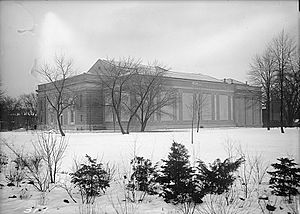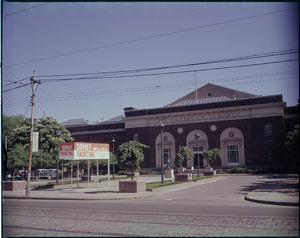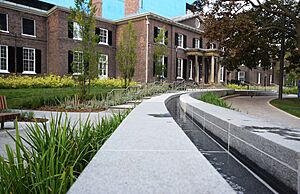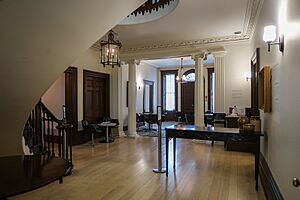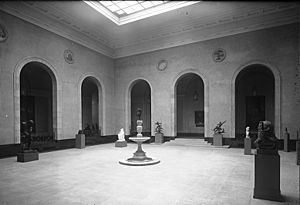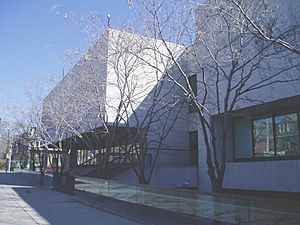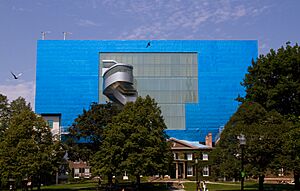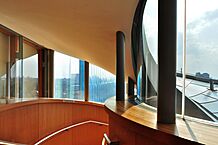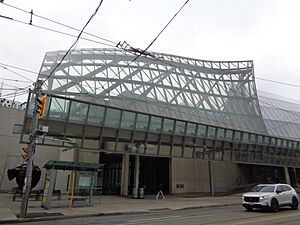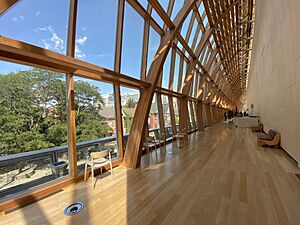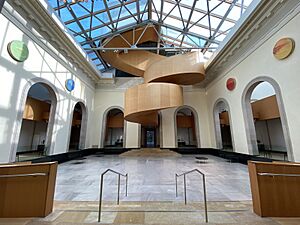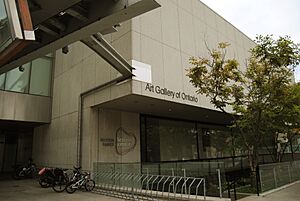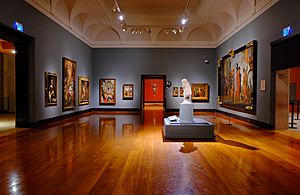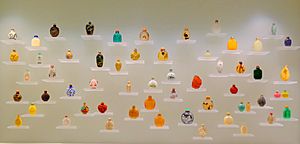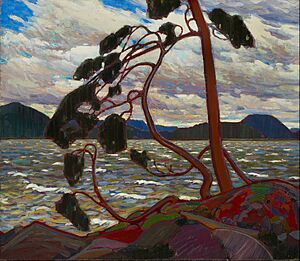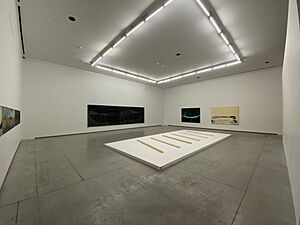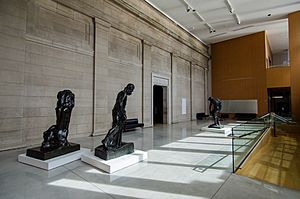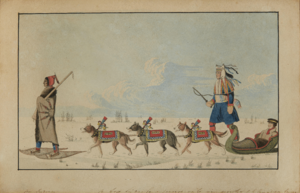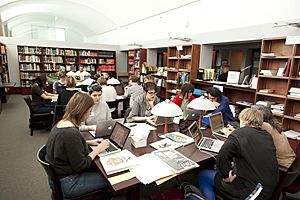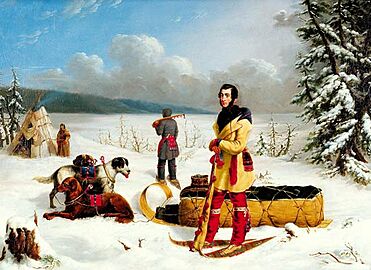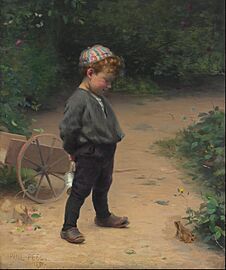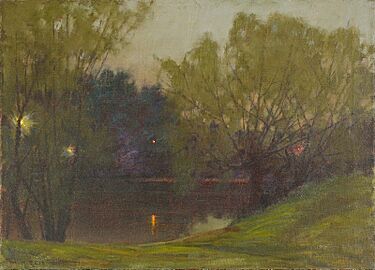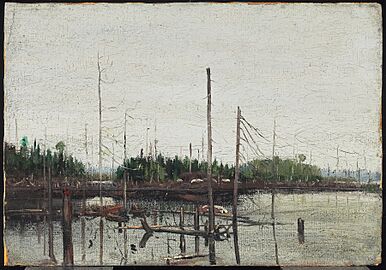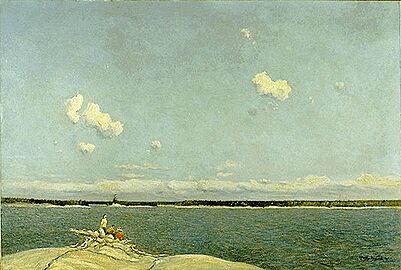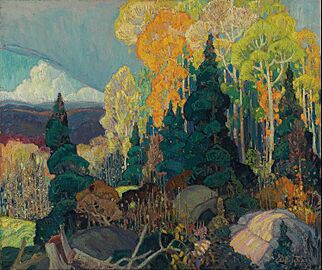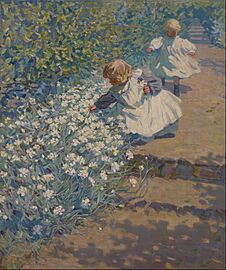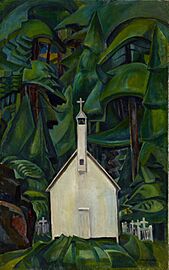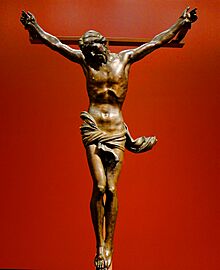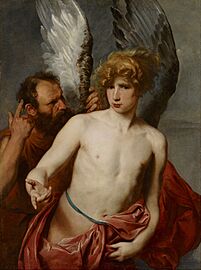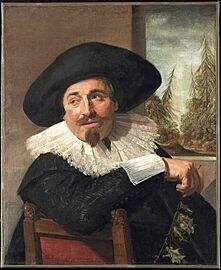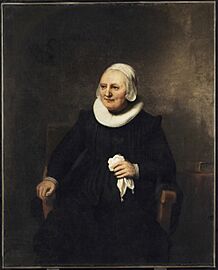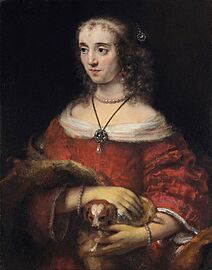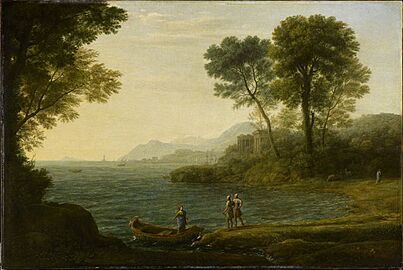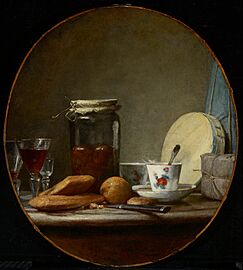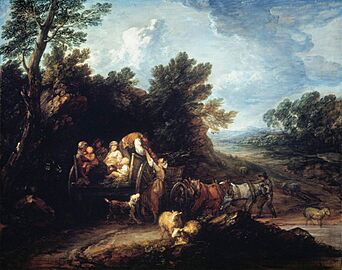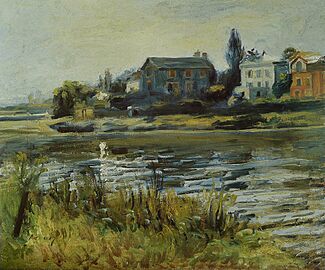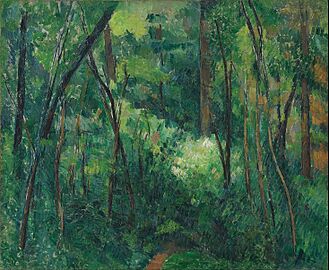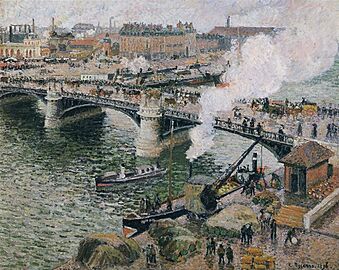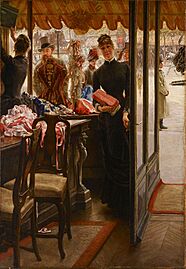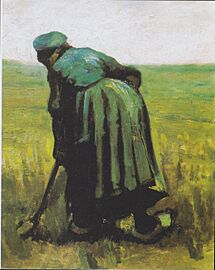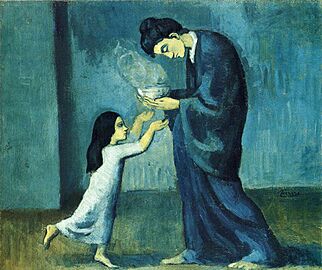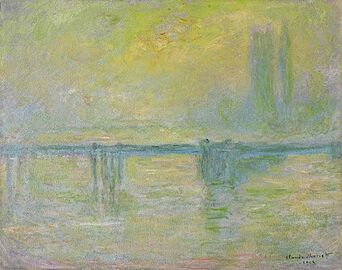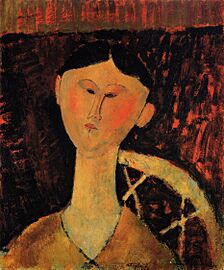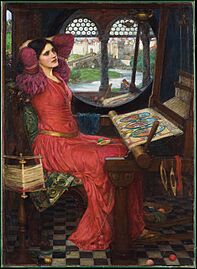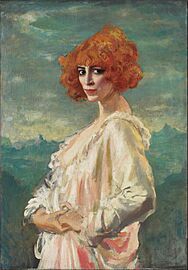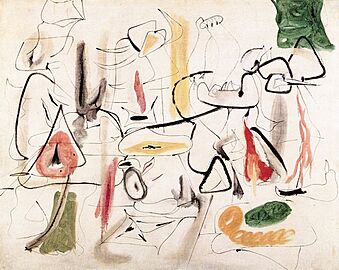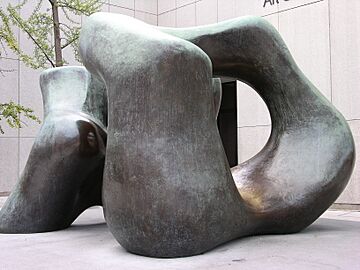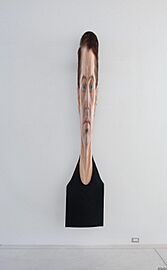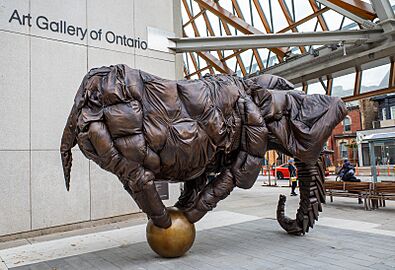Art Gallery of Ontario facts for kids
| Musée des beaux-arts de l'Ontario | |
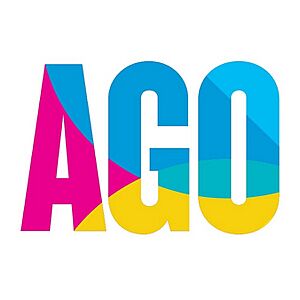 |
|

Dundas Street façade of the AGO in 2023
|
|
| Established | 1900 |
|---|---|
| Location | 317 Dundas Street West Toronto, Ontario M5T 1G4 |
| Type | Art museum |
| Visitors | 846,835 (2023) 84th most-visited globally |
| Public transit access | |
The Art Gallery of Ontario (AGO), also known as the Musée des beaux-arts de l'Ontario in French, is a huge art museum in Toronto, Ontario, Canada. It's located on Dundas Street West in the Grange Park neighbourhood of downtown Toronto. The museum is one of the largest art museums in North America.
The AGO isn't just for showing art. It also has studios for artists, places to eat, event spaces, a gift shop, a library, a theatre, and a research centre.
The museum started in 1900 as the Art Museum of Toronto. It changed its name a few times, becoming the Art Gallery of Toronto in 1919, and finally the Art Gallery of Ontario in 1966. Over the years, the museum has grown a lot, with many new parts added to its buildings.
The AGO has a massive collection of over 120,000 artworks. These pieces come from all over the world and from different times, from the very first century until today. You can find art from Canadian, First Nations, Inuit, African, European, and Oceanic artists. Besides its own collection, the museum also hosts many special art shows that travel from other places.
Contents
A Look Back: History of the AGO
The Art Gallery of Ontario began in 1900. It was first called the Art Museum of Toronto. A group of people who loved art, including artists and important citizens, started it. They wanted a place to show beautiful artworks.
In 1903, the government officially recognized the museum. Before it had its own building, the museum showed art in rented rooms at the Toronto Public Library.
The Grange: A Historic Home Becomes a Museum
In 1909, a woman named Harriet Boulton Smith left her historic home, The Grange, to the museum. This beautiful house was built in 1817. In 1913, The Grange officially opened as the art museum's first home. The museum also made an agreement to keep the land south of The Grange as a public park.
In 1916, the museum started building new galleries next to The Grange. These first new spaces opened in 1918. The museum changed its name to the Art Gallery of Toronto in 1919. This was to avoid confusion with the Royal Ontario Museum, which also showed art. More galleries were added in 1924, including the main entrance on Dundas Street.
In 1966, the museum changed its name again to the Art Gallery of Ontario. This new name showed that it was now the main art museum for the whole province of Ontario.
Growing Bigger: Expansions Over the Years
The museum kept growing in the 1970s. A new part, the Henry Moore Sculpture Centre, opened in 1974. This centre was designed with help from the famous sculptor Henry Moore himself. More new galleries opened in 1977.
In 1993, the museum expanded again, adding many new galleries and making the building much larger. This gave visitors even more space to explore art.
In the early 2000s, the museum planned a huge makeover. A famous architect named Frank Gehry, who was born in Toronto, led this project. It was called Transformation AGO. This was his first big project in Canada!
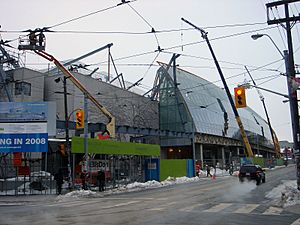
A very generous person named Kenneth Thomson helped a lot with this project. He gave many of his amazing artworks to the gallery. He also donated a lot of money for the renovations.
In 2018, the museum changed the name of a painting by Emily Carr called The Indian Church to Church at Yuquot Village. This was to use more respectful language for Indigenous communities. The museum also looks at other artwork titles to make sure they are appropriate.
In 2019, the AGO made it free for visitors aged 25 and under to enter. This helps more young people experience art.
In 2020, a painting called Still Life with Flowers was returned to the family who owned it before World War II. The family had been forced to sell it during that time. The AGO works to make sure art has a clear history of ownership.
The museum is planning another new gallery space for modern art. This new part, called the Dani Reiss Modern and Contemporary Gallery, will add even more room for amazing artworks.
Exploring the Museum Complex
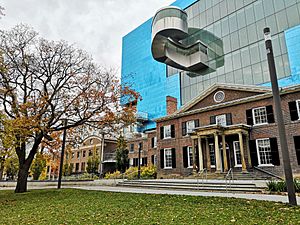
The museum's land was given to it in 1911. It includes The Grange and the park around it. The Grange became the museum's first building in 1913. Since then, the museum has added many new parts to the north and west of The Grange.
The whole museum complex is very large, covering about 45,000 square meters (484,376 square feet). It has two main buildings: The Grange and the much larger main building. After a big renovation in 2008, the museum now has about 12,900 square meters (138,854 square feet) just for showing art!
The museum also owns a large park, Grange Park, right next to The Grange. This park is kept as a public park for everyone to enjoy.
The Grange: A Historic Home
The Grange is the oldest part of the museum. It's a beautiful old house built in 1817. It has two and a half floors and is made of stone and brick. It looks like a Georgian-style building, which was popular a long time ago.
The Grange was a private home for many years. Its owners changed it a few times. When the museum took it over, they restored it to look like it did in the 1830s. For a while, it was a historic house where visitors could see how people lived long ago. Now, it's used for art exhibits and a special lounge for museum members.
The Grange is so important that it was named a National Historic Site of Canada in 1970. This means it's a special place in Canadian history.
The Main Building: A Modern Marvel
The main museum building is next to The Grange. It first opened in 1918 and has been expanded many times. Early plans for the main building included several viewing halls around open courtyards. The design was inspired by the Royal Ontario Museum.
The second part of the design opened in 1926. It included half of the sculpture court, which is now called Walker Court. It also had two more galleries and a new entrance.
The Big Makeover of the 2000s
From 2004 to 2008, the museum had a huge renovation led by architect Frank Gehry. He had to connect all the different parts of the building that had been added over the years.
The outside of the building on Dundas Street changed a lot. The main entrance moved, and a long, curving glass and wood canopy was added. This is called the "Galleria Italia." The roof of Walker Court also got a new look with a glass ceiling that lets in lots of natural light.
The south side of the museum also got a new five-story section. It has a cool spiral staircase made of glass and titanium that sticks out from the building.
Lots of wood was used in the new design, especially Douglas fir. You can see it in the floors, information desks, and stairs, including a spiral staircase in Walker Court.
The renovated museum opened in November 2008. It added 20 percent more space to the museum and almost 50 percent more space for showing art! There's also a special event space called Baillie Court on the third floor.
The Galleria Italia
The Galleria Italia is a long, curving glass, steel, and wood canopy at the front of the museum on Dundas Street. It's also a viewing area on the second floor. It was named after a generous donation from many Italian-Canadian families in Toronto.
The ends of the glass and wood canopy extend past the building. They look like "tears" or rips in the building's wall. The Galleria Italia is made of many pieces of glued laminated timber and glass.
The design of the galleria is very clever. It has two layers of wood and glass that work together to support it and protect it from the weather. Most of the wood came from Douglas fir trees in British Columbia.
People loved the new design! Critics said it was a "restrained masterpiece" and "the easiest, most effortless and relaxed architectural masterpiece this city has seen." They praised how Frank Gehry made the old parts of the museum feel new again.
New Spaces in the 2010s and 2020s
In 2011, the museum opened the Weston Family Learning Centre. This is a fun, hands-on art centre for children and young people. In 2012, the David Milne Study Centre opened, where you can learn about the artist David Milne. The J. S. McLean Centre for Indigenous & Canadian Art was renovated and reopened in 2018.
Amazing Art Collections
The AGO's art collection has grown a lot over the years. In 1960, it had 3,400 artworks. Now, it has over 120,000 pieces! These artworks cover many different art styles and times in history.
The museum organizes its collection into different areas. These areas might focus on a certain type of art, an artist, a time period, or a place. For a long time, the museum mainly collected Canadian and European art. But now, it also has art from Indigenous peoples in Canada, Africa, and other parts of the world.
The museum has about 95 artworks from Africa, mostly from the 1800s. Many of these were given to the museum by Murray Frum.
In 2002, the museum received 1,000 artworks by Aboriginal Australian and Torres Strait Islanders artists. In 2004, Kenneth Thomson donated over 2,000 artworks from his personal collection. This included many Canadian and European pieces, but also art from other cultures.
Canadian Art: Our Stories in Pictures
The AGO has a huge collection of Canadian art, from before Canada became a country up to the 1990s. Most of this art is on the second floor, with many rooms dedicated to showing Canadian pieces.
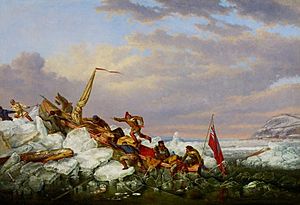
The Thomson Collection of Canadian Art shows a deep look at individual artists. It has almost 650 paintings and works by Canadian artists. This includes 250 works by Tom Thomson (no relation to Kenneth Thomson), 145 by Cornelius Krieghoff, and 168 by David Milne. There are also many pieces by the famous Group of Seven.
The David Milne Study Centre is a special place to learn about David Milne. It has computers linked to his digital archives and films about his life. It also holds 230 items that belonged to Milne, like his diaries and paint boxes.
The J.S. McLean Centre for Indigenous & Canadian Art shows 132 artworks from both Canadian and Indigenous artists. About 40 percent of these works are by Indigenous artists. This centre has 14 rooms, with three dedicated to Inuit art and one to modern First Nations art.
In this centre, artworks are shown together to explore big ideas about Canadian history. This means you might see art from Indigenous and Canadian artists side-by-side. For example, Tom Thomson's The West Wind was shown next to Anishinaabe pouches. This helped show how different people saw northern Ontario at that time. The descriptions for artworks in this centre are in English, French, and either Anishinaabemowin or Inuktitut.
The museum has many landscape paintings by Canadian artists. It also has works by Jack Bush, Paul-Émile Borduas, Kazuo Nakamura, and members of the Group of Seven. The collection includes sculptures by Frances Loring, Esmaa Mohamoud, and Florence Wyle.
The AGO has a large collection of Inuit art, with 2,800 sculptures, 1,300 prints, and many drawings. About 500 of these are shown in the Inuit Visible Storage Gallery.
The museum started collecting First Nations art later, in 1979. This was to avoid having the same art as the Royal Ontario Museum. Now, the AGO shows more First Nations art in its Canadian galleries, including works by Charles Edenshaw and Shelley Niro.
Contemporary Art: Today's Creations
The museum's contemporary art collection features works from artists around the world from the 1960s until today. It also includes Canadian art from the 1990s to now. This collection has installations, photos, graphic art, films, and even music. You can see these works in the Vivian & David Campbell Centre for Contemporary Art and the Galleria Italia.
The collection includes works by Canadian artists like General Idea, Brian Jungen, Liz Magor, Michael Snow, and Jeff Wall. It also has art from international artists who were part of movements like pop art and minimalism. Some of these artists are Jim Dine, Claes Oldenburg, Gerhard Richter, Richard Serra, and Andy Warhol.
The museum has a special permanent exhibit of Yayoi Kusama's Infinity Mirror Room – Let's Survive Forever. This popular room was bought in 2018 after a successful traveling exhibit.
European Art: From Long Ago to the 1900s
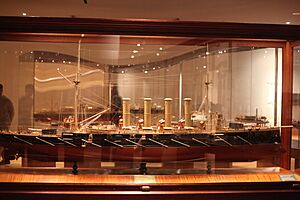
The AGO has a large collection of European art from the year 1000 CE to 1900 CE. You can see these artworks in different rooms, including the Tannenbaum Centre for European Art. The Thomson Collection of European Art also has many paintings and sculptures.
The European Collection includes bronze sculptures and medals, especially from the Baroque period in Italy. In 2004, the museum received over 900 items from the Thomson Collection of European Art. This included 130 ship models.
The Thomson Collection also has the world's largest collection of tiny Gothic boxwood miniatures. One very famous painting in this collection is Massacre of the Innocents by Peter Paul Rubens. Ken Thomson bought this painting in 2002 for a very high price. He wanted it to be a main piece in the collection he gave to the museum.
In 2019, the museum bought Iris Bleus, Jardin du Petit Gennevilliers by Gustave Caillebotte. The European collection also has important works by Gian Lorenzo Bernini, Edgar Degas, Thomas Gainsborough, Paul Gauguin, Frans Hals, Claude Monet, Rembrandt, and Auguste Rodin.
Modern Art: The Early 1900s
The museum's modern art collection includes works from American and European artists from the 1900s to the 1960s. Canadian art from this time is usually part of the Canadian collection. You can see modern art in the Joey & Toby Tanenbaum Sculpture Atrium and the Henry Moore Sculpture Centre.

The AGO has the largest public collection of works by the English sculptor Henry Moore. Most of these are in the Henry Moore Sculpture Centre. Moore gave 300 of his artworks to the museum in 1974. He did this because the museum promised to build a special gallery just for his work. One of his large sculptures, Two Large Forms, was moved to Grange Park in 2017.
The modern collection also has works by Pierre Bonnard, Constantin Brâncuși, Marc Chagall, Otto Dix, Alberto Giacometti, Henri Matisse, Pablo Picasso, and Vincent van Gogh.
Photography: Pictures Through Time

In 2019, the AGO had 70,000 photographs, from the 1840s until today. This includes 495 photo albums from the First World War. You can see photos in two rooms on the ground floor.
In 2017, the museum bought 522 photographs by Diane Arbus. This is the largest collection of her photos outside of New York City. In 2019, the museum also got the Montgomery Collection of Caribbean Photos. This collection has 3,500 old photos of the Caribbean from the 1840s to the 1940s. It's the biggest collection of its kind outside the Caribbean. Other photographers in the collection include Edward Burtynsky, Alfred Eisenstaedt, and Garry Winogrand.
Prints and Drawings: Art on Paper
The museum's prints and drawings collection has over 20,000 prints, drawings, and other works on paper. These pieces date from the 1400s until today. This collection is usually shown in changing exhibits. You can also see it by making an appointment at the Marvin Gelber Print and Drawing Study Centre.
The collection has many works by Betty Goodwin. In 2015, the museum received 170 drawings, prints, and sculptures by Käthe Kollwitz. The collection also includes drawings by David Blackwood, John Constable, Paul Gauguin, Michelangelo, Pablo Picasso, Egon Schiele, and Vincent van Gogh.
Library and Archives: A Treasure Trove of Information
The Art Gallery of Ontario also has the Edward P. Taylor Library & Archives. This library is open to everyone and you don't need to pay to enter. It's a great place to learn about art history.
The Library
The library has over 300,000 books and other materials about art. It's a reference library, which means you can't take books home. It covers Western art from the medieval period to today, art from Canada's Indigenous peoples (including Inuit art), and African and Oceanian art.
The library also has art magazines, newspapers, and over 50,000 art sales catalogues. It has special files on Canadian artists and other art organizations. You can search for materials using their online catalogue.
The Archives
The museum's archives keep records of the AGO's history since it started in 1900. They also have records about The Grange since 1820. These records include files about exhibits, photos, building plans, and letters from artists and collectors.
The AGO's special collections are very important for studying visual arts in Canada. They have many old documents about artists, art dealers, and other people who shaped the Canadian art world.
Programs: More Ways to Engage with Art
Artist-in-residence Program
The AGO has a special program where artists can live and work at the museum. It's called the artist-in-residence program. Selected artists get a studio, money for materials and living costs, and access to the museum's facilities. They are invited to create new art and ideas using all kinds of media, like painting, drawing, photography, and film. This was the first program of its kind at a major Canadian art gallery.
Some past artists who have been part of this program include Gauri Gill, Paul Butler, Margaux Williamson, Diane Borsato, and Sara Angelucci.
Online Presence
The AGO was the first Canadian museum to be part of the Google Art Project (now called Google Arts & Culture). This means you can see 166 artworks from the museum's collection online. These include works by Paul Gauguin, Gian Lorenzo Bernini, Tom Thomson, Emily Carr, and Gerhard Richter.
Selected Works
Canadian collection
- Tom Thomson, The West Wind, 1917
-
Paul Kane, Scene in the Northwest — Portrait of John Henry Lefroy, 1845–46
-
Helen McNicoll, Picking Flowers, c. 1920
-
Emily Carr, The Indian Church, 1929, now called Church at Yuquot Village.
European collection
- Tintoretto – Christ Washing His Disciples' Feet, c. 1545–1555
- Gian Lorenzo Bernini, Bust of Pope Gregory XV, c. 1621
- Circle of Hans Holbein the Younger – Portrait of King Henry VIII, c. 1560s
- Peter Paul Rubens - Massacre of the Innocents, c. 1611–12
- Peter Paul Rubens – The Raising of the Cross, oil on paper version, c. 1638
-
Gian Lorenzo Bernini, The Crucified Christ (Corpus), c. 1650
-
Anthony van Dyck, Daedalus and Icarus, c. 1620
-
Frans Hals, Isaak Abrahamsz. Massa, 1626
-
Nicolas Poussin, Venus, Mother of Aeneas, presenting him with Arms forged by Vulcan, c. 1636–37
-
Carel Fabritius, Portrait of a Seated Woman with a Handkerchief, c. 1644
-
Rembrandt, Portrait of a Lady with a Lap Dog, c. 1665
-
Jean Siméon Chardin, Jar of Apricots, 1758
-
Thomas Gainsborough, The Harvest Wagon, 1784–85
-
Pierre-Auguste Renoir, La Seine à Chatou, c. 1871
-
Gérôme - Painting Breathes Life into Sculpture v1.jpg
Jean-Léon Gérôme, The Antique Pottery Painter: Sculpturæ vitam insufflat pictura, 1893
-
Paul Cézanne, Interior of a forest, c. 1885
-
Camille Pissarro, Pont Boieldieu in Rouen, Rainy Weather, 1896
Modern and contemporary collections
-
James Tissot, The Shop Girl, 1883–1885
-
Vincent van Gogh, A woman with a spade, seen from behind, c. 1885
-
Paul Gauguin - Nave Nave Fenua from the Noa Noa Series - Google Art Project.jpg
Paul Gauguin, Nave Nave Fenua from the Noa Noa Series, 1893–94
-
Pablo Picasso, La soupe, c. 1902
-
Claude Monet, Charing Cross Bridge, brouillard, 1902
-
Amedeo Modigliani, Portrait of Mrs. Hastings, 1915
-
John W. Waterhouse, I Am Half-Sick of Shadows, Said the Lady of Shalott, 1915
-
Augustus John, Marchesa Casati, 1919
-
Arshile Gorky, They Will Take My Island, 1944
-
Henry Moore, Two Large Forms, 1969
-
Brian Jungen, Couch Monster, 2022
See also
 In Spanish: Galería de Arte de Ontario para niños
In Spanish: Galería de Arte de Ontario para niños
- Culture in Toronto
- List of art museums
- List of museums in Toronto


